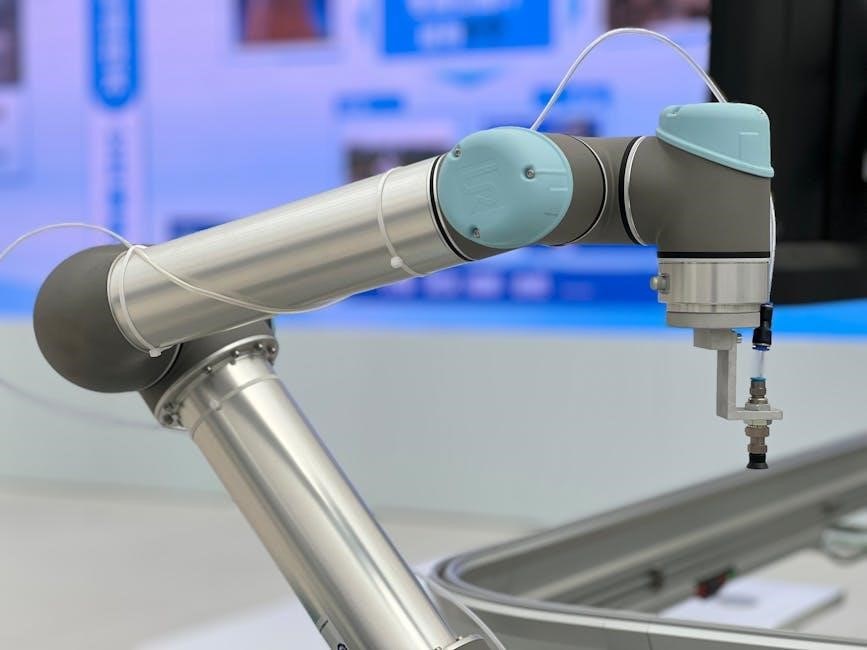Defining the Automation Paradox
The automation paradox explores the contradictory impact of automation. It introduces the concepts of the automation conundrum and paradox as frameworks. These address automation’s ability to streamline operations‚ while acknowledging potential negative effects on human skills and effectiveness.
Conceptual Frameworks: Automation Conundrum and Paradox
The terms “automation conundrum” and “automation paradox” offer conceptual tools for understanding automation’s double-edged nature in modern workplaces. The conundrum lies in the tension between automation’s potential to enhance efficiency and its capacity to displace workers or diminish human capabilities. The paradox‚ further‚ highlights the situation where increased automation necessitates greater human interaction‚ yet simultaneously reduces the likelihood of that interaction being effective. These frameworks help analyze the complex relationship between humans and automated systems.
The Dual-Edged Impact of Automation
Automation presents a dual-edged sword‚ offering both significant benefits and potential drawbacks. On one hand‚ it can streamline processes‚ increase productivity‚ and reduce costs across various industries. However‚ it also raises concerns about job displacement‚ the erosion of expert skills‚ and an over-reliance on automated systems that may lead to decreased human oversight. Understanding this duality is crucial for navigating the complexities of integrating automation into the workforce and broader society. Careful consideration must be given to mitigating potential negative consequences.
The Paradox of Automation in Practice
The more automated a system‚ the more critical human interaction becomes‚ yet its effectiveness diminishes. Automatic systems accommodate incompetence‚ operate easily‚ and can erode expert skills over time‚ creating a paradox.
Human Interaction and System Effectiveness
The automation paradox highlights that as systems become more automated‚ the importance of human interaction paradoxically increases. However‚ the likelihood of effective human interaction decreases. This is because automated systems can accommodate incompetence‚ making them easy to operate‚ even by inexperienced individuals. This can lead to a situation where a lack of skill may not become apparent until a critical point.
Erosion of Expert Skills
A significant aspect of the automation paradox is the erosion of expert skills. While automation aims to improve efficiency‚ it can lead to a decline in the expertise of human operators. As systems become increasingly automated‚ the reliance on human intervention diminishes‚ reducing opportunities for experts to practice and refine their skills. This can result in a loss of critical knowledge and capabilities over time‚ potentially impacting the overall effectiveness and safety of automated systems.
Automation and augmentation represent distinct approaches to integrating technology. Automation replaces human tasks with machines‚ while augmentation enhances human capabilities through technology. Understanding this difference is crucial to navigating the automation paradox effectively.
Distinguishing Automation from Augmentation
Automation involves machines taking over human tasks‚ often predetermined by specific criteria. Augmentation‚ conversely‚ focuses on human-machine collaboration. It enhances human capabilities‚ such as knowledge workers collaborating with AI. Augmentation leverages technology to improve human performance‚ not replace it. Understanding this distinction is key to successfully managing the automation paradox. Automation aims to minimize human intervention‚ while augmentation seeks to maximize human potential through technological assistance.
Automation vs. Augmentation
Collaboration Between Humans and Machines
Effective collaboration between humans and machines is vital in today’s evolving workplace. It is an approach that acknowledges the strengths of both. Humans provide critical thinking‚ creativity‚ and emotional intelligence. Machines offer efficiency‚ speed‚ and data processing capabilities. Combining these attributes creates a synergy that leads to improved outcomes. Augmentation strategies should prioritize seamless integration. Focus should be on building workflows where humans and machines complement each other‚ mitigating risks and maximizing benefits.

AI and the Automation Paradox
AI significantly influences the automation paradox‚ creating both opportunities and challenges. The core tension lies in balancing automation’s efficiency with the need for human oversight and adaptability in complex situations.
The Automation-Augmentation Paradox
The automation-augmentation paradox explores the intricate relationship between AI-driven automation and human augmentation in management. It argues augmentation is intertwined with automation‚ creating dual AI applications. AI’s role magnifies the need to study both concepts‚ revealing a paradoxical tension between them. Organizations must navigate this balance to optimize performance. Understanding this paradox highlights the need for a relational ontology‚ acknowledging the close link between human and machine agents in the digital era.
AI’s Impact on Management
AI’s impact on management is characterized by the automation-augmentation paradox. AI’s role in management presents challenges and opportunities. AI implementation influences decision-making‚ strategy‚ and organizational structure. Examining AI’s effect reveals tensions between automation and augmentation‚ impacting how managers can effectively integrate AI to enhance productivity and innovation. Considering these dual AI applications‚ managers can leverage the strengths of both humans and machines to optimize performance.
Consumer demand is the key to understanding the automation paradox. As consumer preferences evolve‚ companies need to automate production. This helps them meet demand. It also lowers costs and increases efficiency.
The Role of Consumer Demand
Understanding the Key to the Automation Paradox
The key to understanding the automation paradox lies in recognizing the influence of consumer demand. Consumer desires and expectations drive automation. Businesses automate processes to meet these demands more efficiently and cost-effectively. This dynamic creates the paradox. Automation can displace workers. Yet it also generates new opportunities through economic growth. The result is increased consumption. The balance between these forces determines the overall impact of automation.

The Legal Paradox of Automation
The legal paradox arises with technologies like generative AI and self-driving cars. These advancements challenge existing legal frameworks. They raise questions about liability‚ responsibility‚ and evidence admissibility in automated systems.
Generative AI and Self-Driving Cars
Generative AI and self-driving cars exemplify the automation paradox‚ presenting novel legal challenges. Both rely on artificial intelligence‚ exhibiting autonomy. This autonomy raises questions regarding liability when errors or accidents occur. Determining accountability becomes complex. Traditional legal concepts struggle to address these cutting-edge technologies. The absence of human input in these systems raises questions about the application of existing laws and regulations.
Challenges for Procedure and Evidence Law
The automation paradox introduces challenges for procedure and evidence law‚ especially with IoT devices. These devices generate electronic evidence automatically. The absence of human input potentially removes this data from hearsay rules. However‚ questions arise about reliability and authenticity. Managing and interpreting this automated evidence poses difficulties. Legal frameworks struggle to keep pace with the rapid advancements in automation. New procedures and rules are necessary to address these challenges effectively.
Computer automation can lead to greater employment opportunities. Workers in occupations undergoing automation may find new roles. This suggests automation necessitates adaptation and reskilling for continued success in the evolving job market.

The Future of Work
Employment Opportunities and Automation
Despite concerns about job displacement‚ automation can create new employment opportunities. As routine tasks are automated‚ workers can shift to roles requiring creativity‚ critical thinking‚ and complex problem-solving. Adaptability and continuous learning are crucial for navigating this evolving landscape. Investing in education and training programs will equip individuals with the skills needed to thrive in an increasingly automated world. This proactive approach ensures a future where humans and machines collaborate effectively‚ fostering innovation and economic growth.
The Impact of Automation on Hiring Practices
Automation transforms hiring through automated candidate assessment. These systems use predetermined criteria to evaluate applicants. This technology streamlines the initial screening process‚ potentially improving efficiency but raising questions about fairness and bias.
Automated Candidate Assessment
Automated candidate assessment systems revolutionize hiring. They swiftly analyze resumes and applications based on predefined criteria. This technology enhances efficiency by quickly sifting through vast applicant pools. These systems can identify qualified candidates‚ leading to quicker placements. However‚ careful design and monitoring are vital to prevent perpetuating biases. The goal is to ensure fairness and diversity in the selection process while leveraging the strengths of automated tools.
Eliminating Bias in Hiring Decisions
Automated candidate assessment offers the potential to mitigate human biases in hiring. Consistent machine processing‚ based on predetermined criteria‚ can reduce subjective judgments. By focusing on skills and qualifications‚ these systems aim to create a fairer evaluation process. However‚ it’s crucial to acknowledge that biases can still be embedded in the algorithms themselves; Careful design‚ regular audits‚ and diverse data sets are essential to truly eliminate bias and promote equitable hiring practices.
Automation and Productivity Paradox
The automation and productivity paradox highlights the clash between expectations and statistical realities. Despite increased automation‚ productivity growth has slowed. This raises questions about the true impact of automation on economic output and efficiency.
Clash of Expectations and Statistics
The advent of automation promised increased productivity and economic growth. However‚ statistical data often reveals a different picture‚ showcasing a slowdown in productivity despite widespread adoption of automated systems. This discrepancy forms the core of the automation and productivity paradox. The expectation that automation will invariably lead to higher output clashes with the observed reality of stagnating or even declining productivity rates‚ prompting critical examination of implementation strategies and unforeseen consequences.
Maintaining Economic Growth with Automation
Achieving sustained economic growth in an era of increasing automation requires careful consideration. It includes how to navigate the automation paradox. Reducing the capital intensity of production‚ promoting innovation‚ and fostering a skilled workforce are essential. These strategies ensure automation complements rather than hinders economic progress. Policies supporting education‚ retraining‚ and entrepreneurship are crucial to adapt to the changing landscape. These will ensure that economic growth is sustained and benefits all members of society.
Automation and Autonomization
The shift from automation to autonomization represents a significant conceptual change. It involves systems that not only execute tasks but also adapt and learn. This transition requires a re-evaluation of traditional automation paradigms.
Conceptual Shift from Automation to Autonomization
The conceptual shift from automation to autonomization marks a transition from predefined task execution to adaptive‚ learning systems. Autonomization implies a greater degree of independence and decision-making capability within the automated system itself. This evolution challenges traditional understandings of control and responsibility. The rise of generative AI and autonomous vehicles exemplifies this movement. The shift necessitates a re-evaluation of human-machine interaction and the ethical implications of increasingly independent technologies.
Examples of Automation
Generative AI creating content and self-driving cars navigating roads are prime examples of modern automation. These technologies showcase the ability of machines to perform tasks with minimal or no human intervention‚ illustrating advancements in the field.
Generative AI and Autonomous Vehicles
Generative AI and autonomous vehicles exemplify the age of automation‚ with both depending on artificial intelligence. Generative AI can autonomously produce text‚ images‚ and other content‚ while autonomous vehicles navigate highways with minimal human input. These technologies raise questions about the future of work and the need to understand the automation-augmentation paradox. They also present legal challenges related to autonomy and liability‚ highlighting the complexities of these advancements.

Automation in Specific Industries
Automation’s integration into industries like litigation raises questions about procedure and evidence law. The automation paradox is present in legal contexts‚ especially concerning electronic evidence generated by the Internet of Things.
Automation in Litigation
The integration of automation within litigation presents a complex legal landscape‚ impacting both procedure and evidence law. The emergence of electronic evidence‚ particularly from the Internet of Things (IoT)‚ introduces novel challenges. The absence of human input in IoT-derived evidence potentially removes it from hearsay rules. However‚ this automation raises concerns about managing and validating the authenticity and reliability of such technologically generated evidence in civil disputes.
Automation in Production
Automation in production is transforming manufacturing‚ yet presents the automation paradox. While enhancing efficiency and reducing human intervention‚ reliance on automated systems may diminish workforce skills and adaptability. Managing this transition requires balancing technological advancements with maintaining human expertise. The key lies in recognizing the importance of human interaction for effective system oversight and ensuring continued economic growth.
